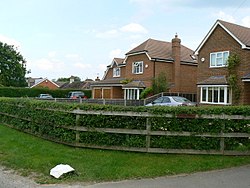Winslade
| Winslade | |
| Hampshire | |
|---|---|
 Modern houses in Hackwood Lane, Winslade | |
| Location | |
| Grid reference: | SU654481 |
| Location: | 51°13’43"N, 1°3’48"W |
| Data | |
| Population: | 224 (2011) |
| Post town: | Basingstoke |
| Postcode: | RG25 |
| Dialling code: | 01256 |
| Local Government | |
| Council: | Basingstoke and Deane |
| Parliamentary constituency: |
Basingstoke |
Winslade is a hamlet in the north of Hampshire, three miles south of Basingstoke, just off the A339 road. The wider parish of Winslade contains the vast Hackwood Park, an 89-acre deer park. The 2011 census recorded the combined populaiton of Winslade, Tunworth, Weston Corbett and Weston Patrick as just 224.
The manor of Winslade was held by Hugh de Port and his descendants from 1086 until 1555, after which it was bought by William, Marquis of Winchester. Hackwood Park was acquired by William Paulet, 1st Marquess of Winchester in the 16th century, and was used as a deer hunting park until the 20th century.
The parish includes Hackwood House, a Grade II* listed building, and a church, St Mary's, built in 1816.
Churches
The Church of England parish church, St Mary's, was built in 1816 Is a Grade II listed building.[1]
The church is a plain rectangular plan with a yellow brick tower and slate roofing. Although the site is old, the present church dates from 1816. The church is described as a "rather unattractive building" with plastered walls, weathered stone bands and slender openings.[2][1]
Also in the village is the former Winslade Congregational Chapel, which stands near a footpath leading to the villages of Herriard and Ellisfield. The chapel was opened in October 1888 by the fifth Earl of Portsmouth and Thomas Maton Kingdon, an ironmonger from Basingstoke. The deacons of London Street in Basingstoke decided to close it in 1930 and was eventually sold to the Portsmouth Estate five years later for £35.
History
The earliest mention of the manor of Winslade is in the Domesday Book of 1086, when it was held by landowner Hugh de Port. In 1275, Winslade was owned by John de St John for "half a knight's fee" by Alan de Hagheman, who purchased the manor a year later.[2] In 1316, the manor was passed to John de Knolle, who then granted it to John de Tichborne after his death in 1331.
The hamlet's name has been spelled in various ways, including Winesflot (11th century), Wineslode (13th century), Wynesflode (14th century), and Wyndslade (16th century).[2]
The manor continued in the Tichborne line until 1562 when the manor was sold to William Paulet, 1st Marquess of Winchester.[2] Hackwood Park was used as a deer park until the early 20th century.[3] The Marquesses of Winchester held the manor until at least 1908.[2]
The 1901 census recorded Winslade with a population of 59.
About the village
Hackwood House is an imposing mansion of symmetrical design, with the original structure dating from 1680. The exterior has four Neo-classical columns, which are situated in front of pilasters raised from the main wall surface. The central doorway is housed in an oval recess and also contains two columns and pilasters at the side. The interior of Hackwood House contains panelling and a large fireplace of late 17th century style, with a carved ornamental festoon brought from Abbotstone House in Wiltshire.[4]
Hackwood Park contains a collection of charming estate buildings, including a fishing temple, a 19th-century teahouse pavilion, a single story mid-18th century orangey, a statue of King George I and a late 19th-century mill house.
Outside links
| ("Wikimedia Commons" has material about Winslade) |
References
- ↑ 1.0 1.1 National Heritage List 1173021: Church of St May (Grade II listing)
- ↑ 2.0 2.1 2.2 2.3 2.4 A History of the County of Hampshire - Volume 4 pp 179-181: Parishes: Winslade with Kempshott (Victoria County History)
- ↑ National Heritage List 1000332: Hackwood Park (Register of Historic Parks and Gardens)
- ↑ National Heritage List 1092734: Hackwood House (Grade II* listing)
